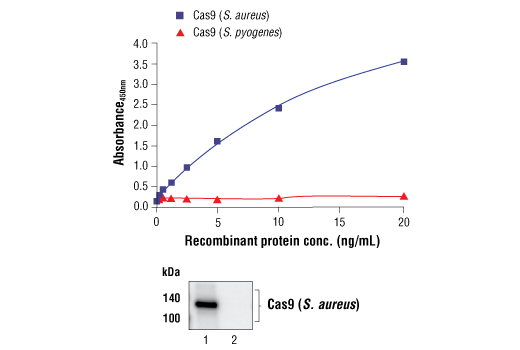| Product Includes | Product # | Quantity | Color |
|---|---|---|---|
| FastScan™ ELISA Microwell Strip Plate, 96 Well | 53257 | 96 tests | |
| Cas9 (S. aureus) Rabbit Capture mAb | 47165 | 1 ea | Green (Lyophilized) |
| Cas9 (S. aureus) Mouse HRP-linked mAb | 58983 | 1 ea | Red (Lyophilized) |
| FastScan™ ELISA Capture Antibody Diluent | 16076 | 3 ml | Green |
| FastScan™ ELISA HRP Antibody Diluent | 28120 | 3 ml | |
| TMB Substrate | 7004 | 11 ml | |
| STOP Solution | 7002 | 11 ml | |
| Sealing Tape | 54503 | 1 ea | |
| ELISA Wash Buffer (20X) | 9801 | 25 ml | |
| FastScan™ ELISA Cell Extraction Buffer (5X) | 69905 | 10 ml | |
| FastScan™ ELISA Cell Extraction Enhancer Solution (50X) | 25243 | 1 ml | |
| FastScan™ ELISA Kit #86538 Positive Control Type 2 | 78574 | 1 ea |
*The microwell plate is supplied as 12 8-well modules - Each module is designed to break apart for 8 tests.
Description
The FastScan™ Cas9 (S. aureus) ELISA Kit is a sandwich enzyme-linked immunosorbent assay (ELISA) that detects endogenous levels of Cas9 (S. aureus). To perform the assay, sample is incubated with a capture antibody conjugated with a proprietary tag and a second detection antibody linked to HRP, forming a sandwich with Cas9 (S. aureus) in solution. This entire complex is immobilized to the plate via an anti-tag antibody. The wells are then washed to remove unbound material. TMB is then added. The magnitude of observed signal is proportional to the quantity of Cas9 (S. aureus).
*Antibodies in kit are custom formulations specific to kit.
IMPORTANT: This FastScan™ ELISA Kit requires 4 washes at Step 6 of the protocol.
Specificity/Sensitivity
Background
The CRISPR associated protein 9 (Cas9) is an RNA-guided DNA nuclease and part of the CRISPR antiviral immunity system that provides adaptive immunity against extra chromosomal genetic material (1). The CRISPR antiviral mechanism of action involves three steps: (i), acquisition of foreign DNA by host bacterium; (ii), synthesis and maturation of CRISPR RNA (crRNA), followed by the formation of RNA-Cas nuclease protein complexes; and (iii), target interference through recognition of foreign DNA by the complex and its cleavage by Cas nuclease activity (2). The type II CRISPR/Cas antiviral immunity system provides a powerful tool for precise genome editing and has potential for specific gene regulation and therapeutic applications (3). The Cas9 protein and a guide RNA consisting of a fusion between a crRNA and a trans-activating crRNA (tracrRNA) must be introduced or expressed in a cell. A 20-nucleotide sequence at the 5' end of the guide RNA directs Cas9 to a specific DNA target site. As a result, Cas9 can be "programmed" to cut various DNA sites both in vitro and in cells and organisms. CRISPR/Cas9 genome editing tools have been used in many organisms, including mouse and human cells (4,5). Research studies demonstrate that CRISPR can be used to generate mutant alleles or reporter genes in rodents and primate embryonic stem cells (6-8).
Cas9 (S. aureus) is a Cas9 ortholog that is smaller, but as efficient, as the more commonly used Cas9 ortholog, Cas9 (S. pyogenes) (9).
- Horvath, P. and Barrangou, R. (2010) Science 327, 167-70.
- Wiedenheft, B. et al. (2012) Nature 482, 331-8.
- Singh, P. et al. (2015) Genetics 199, 1-15.
- Cong, L. et al. (2013) Science 339, 819-23.
- Mali, P. et al. (2013) Science 339, 823-6.
- Li, D. et al. (2013) Nat Biotechnol 31, 681-3.
- Shen, B. et al. (2013) Cell Res 23, 720-3.
- Niu, Y. et al. (2014) Cell 156, 836-43.
- Ran, F.A. et al. (2015) Nature 520, 186-91.
Background References
Cross-Reactivity Key
H: human M: mouse R: rat Hm: hamster Mk: monkey Vir: virus Mi: mink C: chicken Dm: D. melanogaster X: Xenopus Z: zebrafish B: bovine Dg: dog Pg: pig Sc: S. cerevisiae Ce: C. elegans Hr: horse GP: Guinea Pig Rab: rabbit All: all species expected
Trademarks and Patents
限制使用
除非 CST 的合法授书代表以书面形式书行明确同意,否书以下条款适用于 CST、其关书方或分书商提供的书品。 任何书充本条款或与本条款不同的客书条款和条件,除非书 CST 的合法授书代表以书面形式书独接受, 否书均被拒书,并且无效。
专品专有“专供研究使用”的专专或专似的专专声明, 且未专得美国食品和专品管理局或其他外国或国内专管机专专专任何用途的批准、准专或专可。客专不得将任何专品用于任何专断或治专目的, 或以任何不符合专专声明的方式使用专品。CST 专售或专可的专品提供专作专最专用专的客专,且专用于研专用途。将专品用于专断、专防或治专目的, 或专专售(专独或作专专成)或其他商专目的而专专专品,均需要 CST 的专独专可。客专:(a) 不得专独或与其他材料专合向任何第三方出售、专可、 出借、捐专或以其他方式专专或提供任何专品,或使用专品制造任何商专专品,(b) 不得复制、修改、逆向工程、反专专、 反专专专品或以其他方式专专专专专品的基专专专或技专,或使用专品开专任何与 CST 的专品或服专专争的专品或服专, (c) 不得更改或专除专品上的任何商专、商品名称、徽专、专利或版专声明或专专,(d) 只能根据 CST 的专品专售条款和任何适用文档使用专品, (e) 专遵守客专与专品一起使用的任何第三方专品或服专的任何专可、服专条款或专似专专
